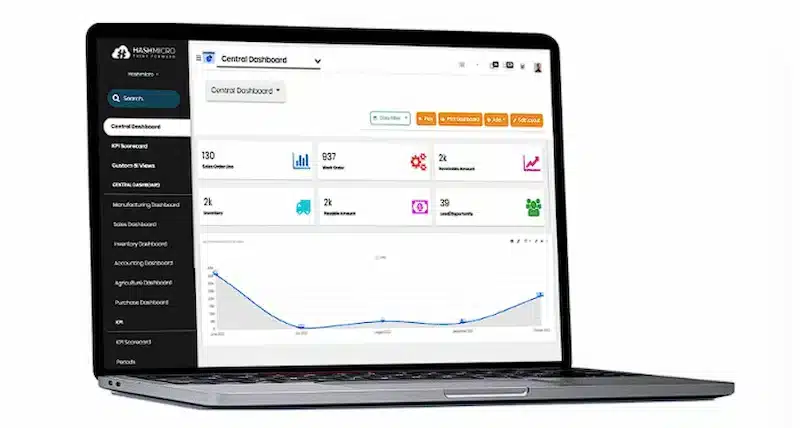Struggling to bridge the gap between sales forecasts and actual operations? You’re not alone. Many growing businesses face the challenge of aligning departments to work toward the same goals. Sales and Operations Planning (S&OP) is a strategic process that helps companies unify their sales, marketing, finance, and supply chain teams through one coordinated plan.
When executed effectively, S&OP improves visibility, enhances decision-making, and ensures that resources are allocated efficiently. Without it, businesses risk miscommunication, missed targets, and costly inefficiencies.
In this article, we’ll explore how S&OP can drive smarter decisions, improve collaboration, and support sustainable growth. You’ll also see how integrated solutions like HashMicro make the planning process smoother and more data-driven through automation and real-time insights.
Basahin mo hanggang dulo para makita kung paano ito makakatulong sa negosyo mo.
Key Takeaways
|
Table of Contents

What is Sales and Operations Planning?
Sales and Operations Planning (S&OP) is a structured, cross-functional business process that helps companies align their sales forecasts with operational capabilities.
It brings together key departments such as sales, marketing, finance, and supply chain to create a unified plan that balances demand and supply while supporting broader business goals.
Rather than working in silos, S&OP enables teams to collaborate, share insights, and make informed decisions based on a single source of truth. By establishing a regular planning cycle, typically every month, businesses can better anticipate market changes, allocate resources more efficiently, and enhance their overall performance.
Steps in the S&OP Process
The Sales and Operations Planning (S&OP) process typically follows a structured monthly cycle that brings together data, people, and plans to support better business decisions. Here are the key steps involved:
1. Data collection and consolidation
The first step involves gathering data from various business units including sales performance, market trends, inventory levels, production capacity, supplier lead times, and financial forecasts.
This consolidated data serves as the foundation for strategic discussions. Without accurate data, the rest of the process is at risk.
2. Demand planning
Sales and marketing teams analyze customer trends, pipeline projections, promotional calendars, and seasonal factors to build a demand forecast.
The goal is to create a realistic view of what the market will require, which directly influences revenue planning and resource allocation.
3. Supply planning
Operations and supply chain leaders review the demand forecast to determine how the business can meet it. This step includes evaluating manufacturing capacity, workforce availability, supplier capabilities, and inventory positions.
It helps identify gaps or constraints that could affect fulfillment or cost-efficiency.
4. Reconciliation and scenario planning (Pre-S&OP)
Before presenting to executives, department heads come together to reconcile the demand and supply plans. This often includes scenario planning, asking “what if” questions to understand the impact of different business decisions.
For example, “What if demand exceeds forecast by 20%?” or “What if a key supplier falls short?”
5. Executive S&OP review
This is the decision-making core of the process. Business leaders evaluate the proposed plan in the context of broader strategic goals. They review trade-offs, validate revenue and cost assumptions, and align resources across departments.
The approved plan becomes the official operational and financial roadmap for the period ahead.
6. Performance monitoring
Once the plan is agreed upon, execution begins across sales, production, procurement, and logistics. KPIs and dashboards are used to track performance in real time.
If variances occur such as sudden demand shifts or supplier delays, the business can adjust quickly without losing alignment.
Benefits of S&OP
Sales and Operations Planning (S&OP) isn’t just a process, it’s a strategic approach that helps businesses make smarter, more coordinated decisions. When implemented effectively, S&OP delivers clear business value across multiple functions. Here are some of the key benefits:
1. Improved cross-functional alignment
S&OP brings together departments that often operate in silos sales, marketing, operations, finance, and supply chain ensuring everyone works toward shared business goals.
This alignment reduces miscommunication, increases accountability, and supports faster decision-making.
2. Better demand and supply balance
By integrating forecasts with operational planning, S&OP helps businesses match supply with actual market demand. This results in fewer stockouts, lower excess inventory, and more efficient use of production capacity.
3. Enhanced financial performance
With a clear view of demand, capacity, and cost implications, companies can plan more accurately and avoid unnecessary spending. This has a positive impact on margins, cash flow, and overall financial predictability.
4. Faster, more informed decision-making
S&OP equips leaders with real-time data and insights, allowing them to respond more quickly to changes in market conditions, customer behavior, or internal constraints. Strategic choices can be made with confidence, not guesswork.
5. Increased customer satisfaction
When supply matches demand and orders are fulfilled on time, customer experience naturally improves. A well-executed S&OP process supports reliable delivery schedules and consistent product availability.
6. Stronger risk management
Scenario planning, a core component of S&OP helps businesses prepare for potential disruptions, such as supplier delays, sudden demand spikes, or economic shifts. Being proactive rather than reactive strengthens resilience and business continuity.
Inputs and Outputs of S&OP
Sales and Operations Planning (S&OP) is a cross-functional process that relies on a wide range of inputs to create a unified, forward-looking plan.
These inputs are gathered from various departments including sales, marketing, finance, operations, and supply chain for making informed decisions that align supply with demand.
Key inputs of S&OP:
- Sales forecasts: Projected customer demand based on historical data, market trends, and promotional plans.
- Marketing plans: Upcoming campaigns, product launches, or events that could impact demand.
- Inventory levels: Current stock positions, including safety stock and slow-moving items.
- Production capacity: Manufacturing capabilities, lead times, and potential constraints.
- Supply plans: Supplier capabilities, procurement schedules, and inbound logistics.
- Financial goals: Revenue targets, cost constraints, and profitability benchmarks.
Key outputs of S&OP:
- Consensus demand plan: A unified forecast agreed upon by sales, marketing, and operations.
- Supply plan: A production and procurement schedule that supports the demand plan while considering capacity and resource constraints.
- Inventory plan: Strategies to optimize inventory levels, improve service rates, and reduce carrying costs.
- Financial plan alignment: Ensures that operational plans support financial objectives and resource allocation.
- Executive summary and KPIs: A high-level overview for leadership, highlighting key performance indicators, risks, and action plans.
S&OP Maturity Levels and Models
The effectiveness of Sales and Operations Planning (S&OP) depends mainly on an organization’s level of maturity in the process. Understanding a company’s position on the S&OP maturity curve is crucial for identifying gaps, setting realistic goals, and driving continuous improvement.
What are S&OP maturity levels?
S&OP maturity levels represent the stages of evolution an organization undergoes as it develops a more integrated, collaborative, and data-driven planning process.
These stages typically range from basic, siloed efforts to a fully optimized, strategic function that supports long-term business goals. Although there are several models used across industries, most follow a similar five-level structure:
Level 1: Reactive / disconnected
Planning is done in silos with limited communication between departments.
Decisions are often reactive, based on short-term issues rather than forward-looking insights.
Level 2: Functional / basic collaboration
Some level of cross-functional communication begins.
Demand and supply plans exist but are not fully aligned or reconciled.
Level 3: Integrated / cross-functional
Sales, operations, finance, and other key teams collaborate in a structured Sales and Operations Planning (S&OP) process. A monthly planning cycle is established, and data increasingly drive decisions.
Level 4: Managed / advanced planning
The S&OP process is formalized and consistent.
Integrated business planning (IBP) is emerging, aligning operational plans with financial and strategic objectives.
Level 5: Strategic / optimized
S&OP is fully embedded into the organization’s strategic planning process.
Real-time data, advanced analytics, and scenario planning are used to drive proactive, company-wide decisions.
Challenges of Sales and Operations Planning
S&OP offers excellent value, but implementing it isn’t always easy. Many companies encounter roadblocks that slow progress and reduce impact. Here are some of the most common challenges:
1. Lack of executive support
Without strong leadership involvement, S&OP lacks authority, direction, and long-term commitment. Executive backing is essential to drive alignment, enforce accountability, and ensure that the process supports broader business strategy.
2. Poor cross-functional collaboration
S&OP is built on teamwork across departments. When functions like sales, operations, and finance don’t communicate or align, the result is fragmented planning and missed opportunities.
3. Inaccurate or inconsistent data
Reliable, real-time data is the foundation of good planning. Disconnected systems or manual inputs frequently result in forecasting errors, supply-demand mismatches, and suboptimal decision-making.
4. Misalignment between supply and demand
When demand plans don’t match supply capabilities, businesses face either lost sales due to stockouts or excess inventory that ties up capital and storage space.
5. Inflexible and manual processes
An S&OP process that is slow, spreadsheet-heavy, or overly rigid can’t respond quickly to market changes. Agility is critical in today’s fast-moving business environment.

Streamline Your Sales and Operations Planning with HashMicro’s Smart ERP Solution
An effective Sales and Operations Planning (S&OP) process requires more than just coordination, it demands real-time data, seamless collaboration, and the ability to adapt to changes quickly.
HashMicro’s Smart ERP (Enterprise Resource Planning) solution is designed to simplify and strengthen your S&OP process by providing an end-to-end platform that connects every part of your business.
Whether you’re struggling with forecast accuracy, planning bottlenecks, or cross-functional alignment, HashMicro ERP software offers the tools to transform your approach and drive better results. Key features that support smarter S&OP:
- Complete visibility and analysis: HashMicro SCM software offers clear visibility into products and materials, helping businesses manage inventory accurately and respond quickly to changing market demands.
- Controlled warehouse management: With the warehouse management feature, companies can oversee supply chain operations across multiple warehouses while minimizing human error.
- On-time delivery: HashMicro SCM software automates the entire process from order placement to delivery, ensuring products reach customers right on schedule.
- Sales forecasting: The system provides reliable sales forecasts that help businesses stay in tune with market trends and quickly adapt their sales and operational strategies.
- System integration: HashMicro SCM integrates seamlessly with CRM-Sales systems, making it easier to generate sales orders, create quotations, and manage price lists and commissions automatically.
- Shipment tracking and returns management: The tracking feature ensures all customer orders are delivered on time, while return processes are handled efficiently with real-time inventory updates.
- Planning and forecasting: This feature enables businesses to accurately predict future stock needs using data-driven analysis of current inventory trends.
Conclusion
A well-executed Sales and Operations Planning (S&OP) process is essential for aligning your business strategy with day-to-day operations. By improving forecast accuracy, enhancing collaboration, and increasing visibility across departments, companies can respond more quickly to market demands and achieve better performance.
HashMicro solution is designed to support and simplify your S&OP process with powerful, integrated tools tailored to your business needs. Whether you’re looking to streamline planning, reduce costs, or boost efficiency, our system helps you make smarter, data-driven decisions.
Ready to experience it for yourself? Book a free demo today and discover how HashMicro can transform the way you plan and operate.

FAQ Sales and Operations Planning
-
What is the 5 section sheet in S&OP?
If you’re looking to improve your S&OP process and gain a clearer view of your data, the 5-Section Sheet is worth exploring. It helps you validate your numbers, review past performance, anticipate future changes, and ultimately make better decisions.
-
Is S&OP a supply chain?
Sales and operations planning (S&OP) is a supply chain planning process to help business leaders make decisions on a wide range of topics including: Balancing demand plans with supply plans. Making planning adjustments in sales and operations execution (S&OE)
-
Is MRP a part of ERP?
An ERP system will give you control across the whole process, from the supply of raw material to the logistics of delivery. An MRP module is a crucial component of ERP systems, but it is not the sole focus of the solution.






































